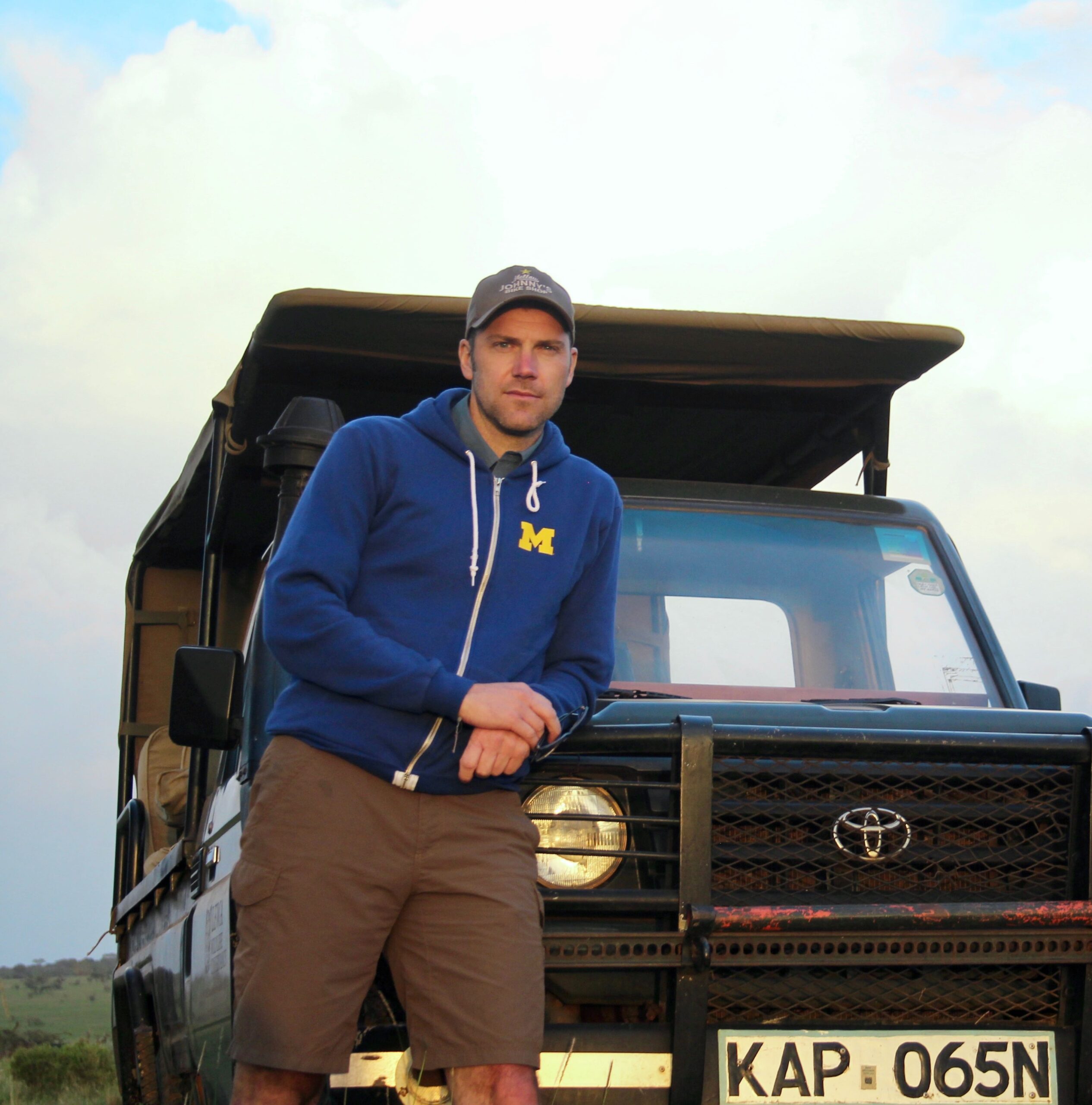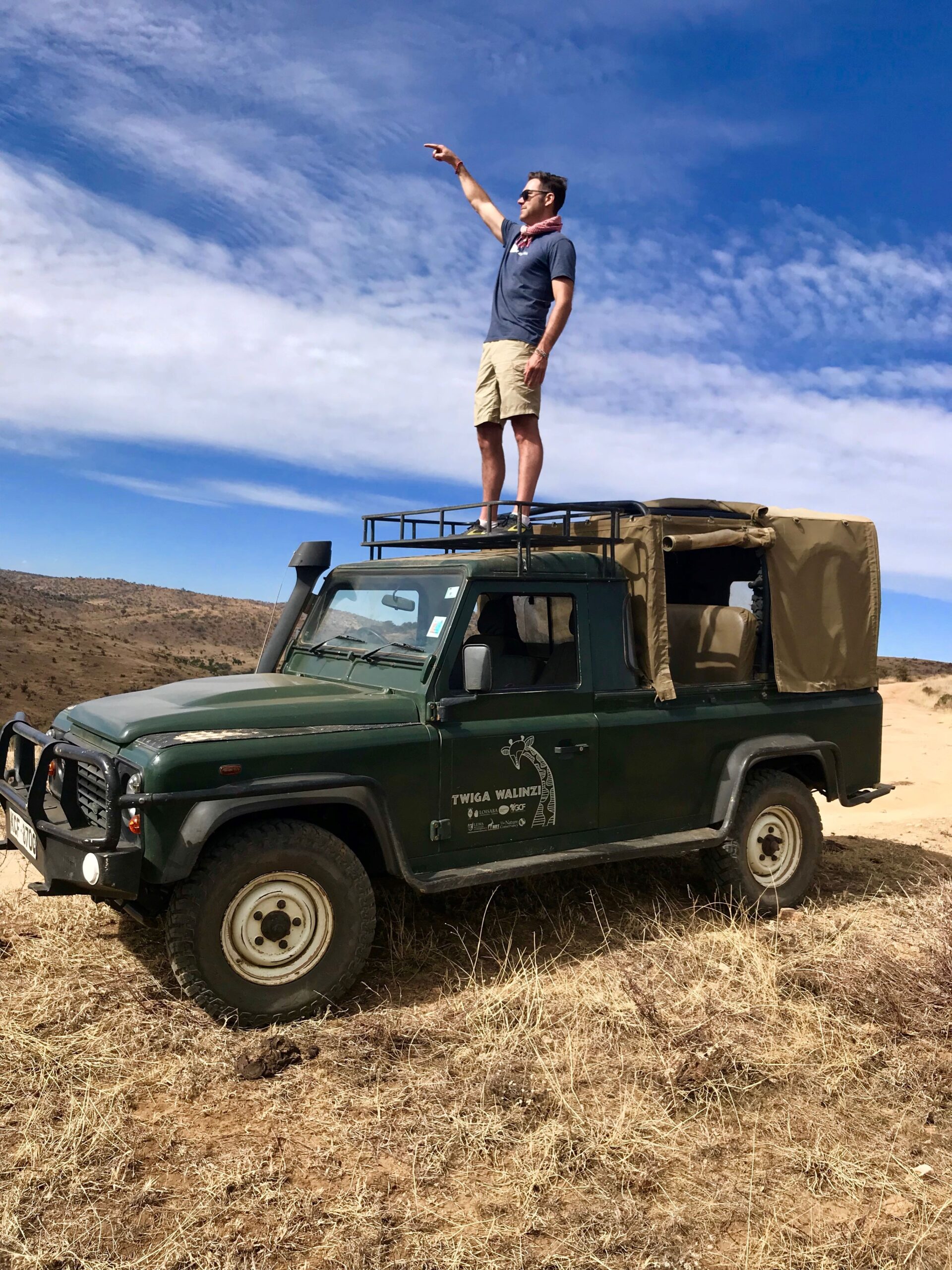Even David O’Connor, MS’13, chuckles at the unlikely reality of his life. An Irish national. In Kenya. Working to safeguard giraffes.
Yet that has been O’Connor’s prevailing existence throughout the last decade, a globetrotting life ignited by a childhood fascination with wildlife and professionally honed as a U-M graduate student.
“I couldn’t have dreamt this up as a kid,” O’Connor says.
Now 45 years old, O’Connor traces his interest in wildlife to a youthful experience in Waterford, the Irish county best known for its eponymous crystal. When he stumbled upon a fox den near his childhood home, a curiosity about nature took root as he watched the vixen care for her cubs and those same young foxes explore the rural lands. While devouring nature documentaries and the National Geographic magazines that arrived in his mailbox each month, O’Connor’s zeal for wildlife accelerated.
“Before the internet, these were the windows into the world for a boy from rural Ireland,” O’Connor says.
Though young, he quickly noticed that most of the Emerald Isle’s big wildlife species — giant elk, red deer, and wolves among them — had diminished as agriculture spread and consumed more and more space on the North Atlantic island. Though that realization proved troubling, it also sparked hope and propelled O’Connor’s personal commitment to conservation.
“After all,” he says, “there were still animals to protect.”
With an admitted “frenetic attitude” toward wildlife and conservation, O’Connor earned a degree in zoology and earth sciences at University County Cork before venturing to Ann Arbor in 2010 to pursue a graduate degree in conservation ecology at the School for Environment and Sustainability (then the School of Natural Resources). He was confident that the program’s multidisciplinary approach, which included courses in business, engineering, and the social sciences, would empower a more hands-on approach to conservation.
“When it comes to conservation, you need all of those skills,” O’Connor says.
Presented with an opportunity to do graduate research in Kenya, O’Connor surveyed the conservation landscape in Africa for a subject. He noticed extensive work in elephants, rhinos, lions, and other prominent African wildlife, yet discovered that the giraffe, an exclusively African animal, remained largely overlooked.
“That was my opportunity to make an impact,” says O’Connor, enthusiastically recalling his first encounter with a giraffe as a 10-year-old boy at Ireland’s Fota Wildlife Park. “It was like looking at a dinosaur, something so unique, so exquisite. That always stuck with me.”

O’Connor focused his thesis on the foraging ecologies of giraffe in northern Kenya, an investigation that intensified his childhood fascination with the giraffe and sparked a now decade-long relationship with the long-limbed animal.
Ask O’Connor about the giraffe today and his eyes widen. He wastes neither time nor breath detailing the wonder of an iconic species in global lore as well as an important animal in the African ecosystem.
“Watch giraffes for any length of time in the wild, and it’s hard not to be amazed,” he says with a softening Irish brogue. “They’re so big, yet graceful and nimble. So powerful, yet they only eat leaves. We don’t know how they communicate with one another, but it’s clear they do by how their heads snap back when another makes a cue or how they move together with such purpose.”
And even more to O’Connor’s conservationist sensibilities, the giraffe is quietly disappearing from the African wild. The giraffe population has declined nearly 40% over the last three decades. At present, three of its four species are considered endangered while two subspecies are critically endangered.
“It’s such an iconic species, and we can’t let it slip away,” he charges.
“It was like looking at a dinosaur, something so unique, so exquisite. That always stuck with me.”
O’Connor parlayed his graduate research into a position with San Diego Zoo Global, the nonprofit organization that operates the famed San Diego Zoo and aims to “lead the fight against extinction.” Over a six-year run with the organization, O’Connor traveled to Africa regularly to study the giraffe and, more importantly, implement a community-led approach to conservation.
“There’s a misconception that conservation is about wildlife when really it’s about people and, specifically, how local people share space with wild animals,” O’Connor says.
He spearheaded the creation of Twiga Walinza (“Giraffe Guards”), a novel program in which O’Connor and his colleagues trained Kenyans to monitor and collect giraffe data and engage communities, while also supporting related jobs, such as anti-poaching rangers.
“These positions allow local residents to see benefits coming to them through the giraffe, which makes them more bonded with the animals and more eager to protect them,” O’Connor says.

The conservation ecologist has also been a key cog in the collaborative Twiga Tracker effort led by the Giraffe Conservation Foundation, in which crews have attached satellite tracking units to nearly 200 giraffes across all four species and eight African nations. The tracking units, which take account of the giraffes every hour, provide information on giraffe movement and enable researchers to calculate home range size, corridors of movement, and navigation patterns to guide investment in resources and on-the-ground conservation practices. With information on giraffe locations, for instance, rangers can deploy manpower to protect the animals from poaching.
“We’re seeing great signs of hope with those programs,” O’Connor says.
In 2019, meanwhile, O’Connor co-authored the most comprehensive and accurate geographical range map for giraffe in sub‐Saharan Africa to date — a critical effort to conservation and policy planning given substantial changes in land use as well as declining giraffe numbers and persistent data gaps. The study found that roughly 70% of the current geographic range of giraffes occurs outside government‐managed protected areas, where much of the habitat has been significantly affected by urban development, increased agriculture, and livestock overgrazing.
Today, as president of Save Giraffes Now, a U.S.-based nonprofit that invests in projects to save giraffes in Africa from extinction, O’Connor continues advocating for expanded giraffe range land. Simultaneously, he develops programs to provide both the giraffes and those with whom they live with heightened opportunities to thrive.
“I could easily do this for the rest of my career,” he says of his unlikely, yet purposeful reality protecting giraffes.
“There’s plenty more we can do to help giraffe and the people who live with them, and that’s where my focus remains.”
A frequent contributor to Michigan Alumnus, Daniel P. Smith has penned profiles of notable alumni such as business tycoon Sam Zell, U.S. Congresswoman Grace Meng, and Five Guys’ founder Jerry Murrell.





